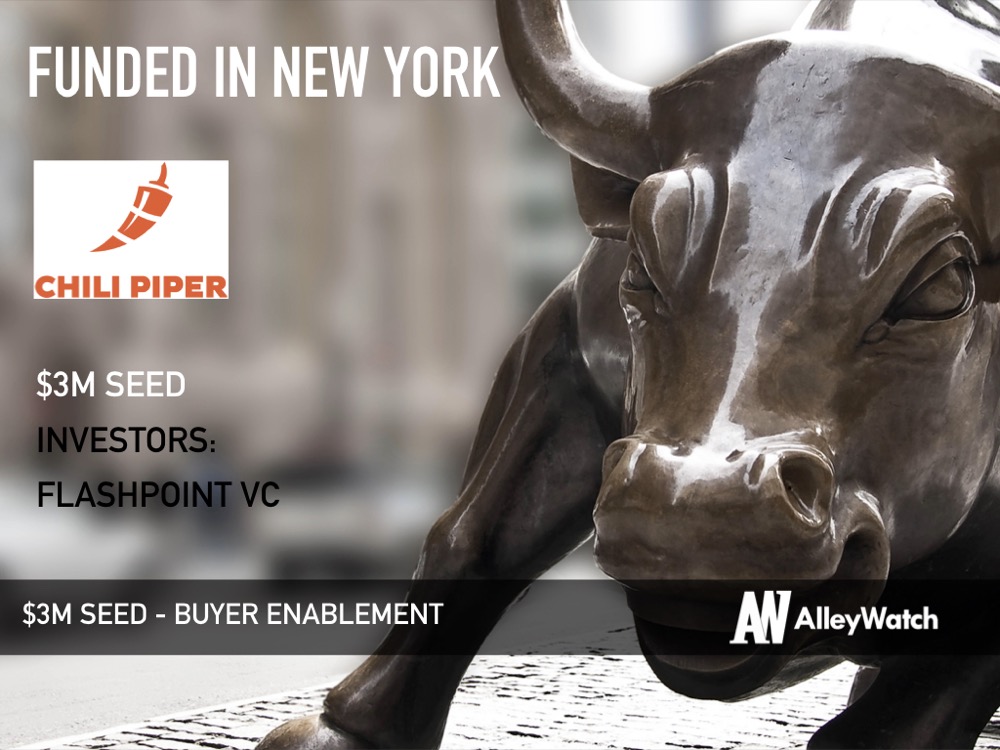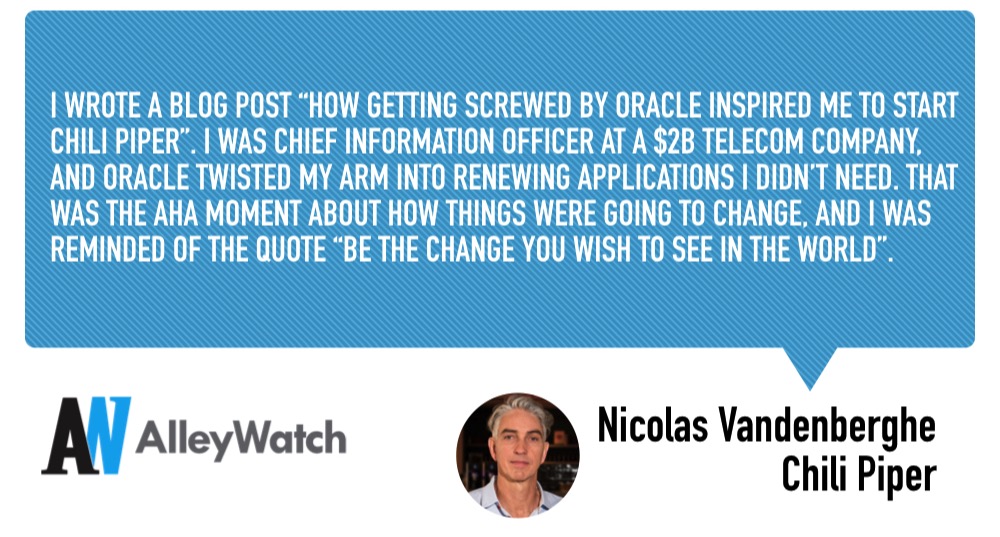The compelling vision and inspiration behind this startup are perfectly captured in the founder’s blog post “How getting screwed by Oracle inspired me to start Chili Piper.” In fact, founder and CEO Nicolas Vandenberghe was so fed up with his experience with Oracle that he left behind the $2B telecom company that he was the CIO for and decided to venture out on his own. Chili Piper helps buyers interact with sellers in a completely new way. The company’s signature “Concierge” method automatically connects prospects to the right person, via phone or calendar at the right time. Over 300 tech companies including names like Square, Intuit, & Greenhouse are customers. A lot of attention has been focused on sales teams internally managing their processes but this startup looks to shift the paradigm towards empowering the buyer – the one with the purse strings.
AlleyWatch sat down with CEO and founder Nicolas Vandenberghe to learn about why Chili Piper is leading the new frontier of Buyer Enablement technology. We also discussed why VCs are drawn to Chili Piper’s mission. With its latest round, the company has now raised $3.4M across three rounds.
Who were your investors and how much did you raise?
Our investor is Flashpoint VC, a Venture firm focused on Eastern and Central Europe where our technical resources are located (we’re globally distributed). It’s a $3M seed round.
We had bootstrapped past $2M in ARR before deciding it was time to accelerate our product development – the market ahead of us is huge.
 Tell us about the product or service that Chili Piper offers.
Tell us about the product or service that Chili Piper offers.
Chili Piper builds software for customer-facing teams. Our vision is that a lot of technology has been deployed to automate internal processes, starting with Customer Relationship Management and email campaigns.
The next wave will be technology that is external-facing, meaning it actually helps Buyers interact with Sellers. We call this “Buyer Enablement”.
Internal facing tech increases Sales productivity, so it increased revenues indirectly, where external facing tech increased revenues directly, by making Buyers more likely to buy.
This is the ultimate vision. We had to start somewhere, so we focused on scheduling, a process involving both Sellers and Buyers. We were shocked to discover one of the industry’s best-kept secret: companies lose up to 80% of their qualified leads after the leads fill a web form, simply because it takes them hours or days to respond. We built “Concierge”, an intelligent JavaScript snippet that plugs into forms to qualify, route and connect prospects in real time. Prospects get a much better experience, and not surprisingly conversion rates typically double.
What inspired you to start Chili Piper?
I wrote a blog post “How getting screwed by Oracle inspired me to start Chili Piper”. I was Chief Information Officer at a $2B telecom company, and Oracle twisted my arm into renewing applications I didn’t need. That was the aha moment about how things were going to change, and I was reminded of the quote “Be the change you wish to see in the world”.
Is there a specific meaning behind the name of the company?
We wanted something playful and memorable, yet relevant to our space.
We were brainstorming around conversion rates and pipeline. Somebody brought up a quote famous in Europe – “he who pays the piper calls the tune”; someone else added “chili” in front of piper, and there, we knew we had it: Chili Piper, the solution that makes your pipeline hot.
How is Chili Piper different?
We compete through innovation – looking at problems with novel eyes and coming up with solutions focused on improving the User eXperience. Concierge is a brilliant example. With the new funding, we have many more ideas that we can’t wait to bring to our customers.
What market does Chili Piper target and how big is it?
Our market is the money companies spend on marketing, sales, and customer success technology. It’s been pegged at $30B to $50B, depending on the sources.
What’s your business model?
We’re a pure SaaS player, based on subscription. With the new funding, we will soon add a free tier, “Chili Free”, a line of products to bring our solution to a broader audience.
What was the funding process like?
We were fortunate to have generated enough of a reputation to get inbound interest from VCs. We had received a handful of offers, Flashpoint stood out because of their global angle and their ability to help us in Central and Eastern Europe, where recruiting talent is our immediate priority.
What are the biggest challenges that you faced while raising capital?
To bootstrap, one cannot spend two years re-writing an entire industry stack, like WorkDay did for example. You have to pick a narrow yet acute problem, that can be solved in a few months. We started in January 2016 and were cash positive by October. So VCs looked at our solution and found it … narrow! It’s the proverbial case of the tree hiding the forest.
You have to pick a narrow yet acute problem, that can be solved in a few months. We started in January 2016 and were cash positive by October. So VCs looked at our solution and found it … narrow! It’s the proverbial case of the tree hiding the forest.
Fortunately, some bought into our Buyer Enablement vision, especially the founders at Flashpoint. We’re thrilled to partner with them.
What factors about your business led your investors to write the check?
By far the most impressive thing about Chili Piper is our customer list; it looks like the who’s who of tech companies – Square, Intuit, Greenhouse, and three hundred more, including one of the tech titans under NDA.
What are the milestones you plan to achieve in the next six months?
We took this Seed financing to hire more engineers and bring to market some strong ideas, some new angles on existing problems. Most of them should go live before six months.
What advice can you offer companies in New York that do not have a fresh injection of capital in the bank?
A very common mistake is to interpret or imagine what VCs want to hear and start building the product, the business and the story in that direction. That very rarely works to get funding, and if it does, the company will likely tank shortly after.
VCs succeed by detecting signs of success, not by laying out blueprint visions that entrepreneurs only need to follow.
A very common mistake is to interpret or imagine what VCs want to hear and start building the product, the business and the story in that direction. That very rarely works to get funding, and if it does, the company will likely tank shortly after.
VCs succeed by detecting signs of success, not by laying out blueprint visions that entrepreneurs only need to follow.
It’s up to the entrepreneur to come up with the vision and start achieving even minor steps towards success.
The best approach is to build a model on how success will be achieved, identify the critical elements in this model, and spend money and resources only to build evidence of success on these critical elements.
Where do you see the company going now over the near term?
Our product Concierge has universal appeal among B2B companies, so we’re going to market it aggressively. Our next milestone is the $5M ARR mark, we should get to it soon. In parallel we’re going to release some amazing products, that’s the second stage of our rocket ship.
Our ultimate goal is to grow the Company and take it public, following the footsteps of companies like HubSpot and Zoom.
What’s your favorite restaurant in the city?
Maison Première in Williamsburg. Delicious seafood, super creative cocktails, and a very unique atmosphere. That’s where I take all my food-snob friends visiting from France!





